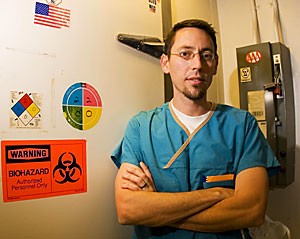Dr. Don Christensen, chief pathologist at University Medical Center, can recall the exact moment in his pathological tenure when the mystique of working in the morgue lost its aura.
While performing an autopsy on a body that was thoroughly dissected and stripped of its organs, Christensen glanced over at the body, then went back to what he was doing.
At that point, he realized that he had become desensitized from working with dead bodies.
“”What we’re doing here is quite dramatic,”” Christensen said, “”but we have to be able to function and not get distracted.””
Becoming used to the morgue atmosphere is just part of being an effective pathologist, said Carlo Valentino, UMC resident pathologist.
“”After working with bodies for a while, it’s less mysterious,”” he said. “”There’s less of a ‘wow’ factor and more of a scientific outlook.””
During medical school, he and his fellow students acted timidly, especially when faced with the task of removing organs from donated bodies, Valentino said. After dealing with countless bodies and removing several livers and kidneys, the task became second nature.
“”We’re the doctor’s doctor,”” he said. “”Doctors ask us questions like, ‘What’s going on with this guy’s liver we sent you?’ “”
While to some, the idea of a morgue may conjure up thoughts of a damp, dark basement room filled with dead bodies, reality paints a less creepy picture, Christensen said.
When entering the morgue in the bowels of UMC, it is unlikely you will see a dead body, unless an autopsy is being conducted, and even that may not occur every day.
“”We may not do autopsies every day, but I’d say we do them several times a week,”” he said. “”I’ve had people think I just do autopsies or that I do what the people on ‘CSI’ do – in reality, pathology is much more than that.””
Most of the work pathologists do includes analyzing tissue and organs coming out of the operating room to properly diagnose a patient, as well as running the blood bank, doing laboratory work and conducting biopsies, Christensen said.
Several steps must be taken when a body goes through the morgue, said Dr. Richard Sobonya, UMC chief of autopsy.
After a patient within the hospital dies, the body is sent to the morgue. If the patient’s family requests it, or further exploration of the body is needed to achieve a proper diagnosis, an autopsy takes place, he said.
If the autopsied patient is an organ donor, organ donor network employees then harvest the necessary organs and the body is released to a funeral home, Christensen said.
Although the common misconceptions of the morgue are sensationalized by television shows and movies, UA pathologists like Valentino are secure with their career.
“”It’s not scary or horrific,”” he said. “”I love it and wouldn’t be doing anything else.””









